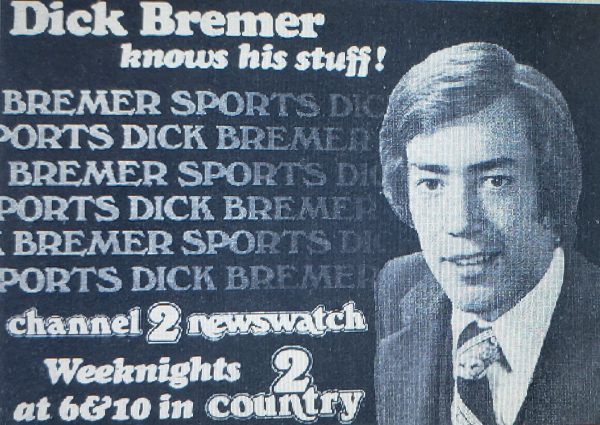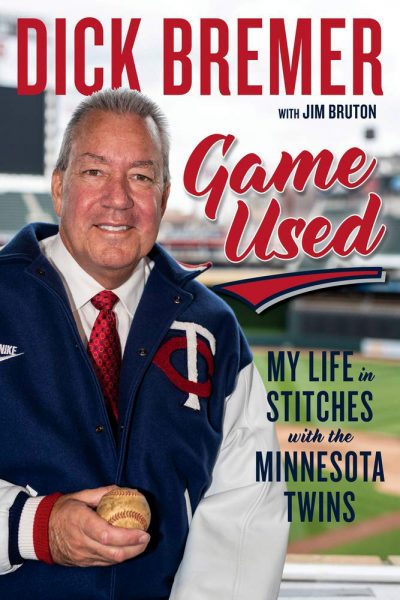Of all the non-players connected in some manner with the Minnesota Twins over the near-60 years that they’ve been in existence, I’m not sure you could find one more recognizable to Twins fans than Dick Bremer.
If you’ve been watching Twins telecasts since 1983, you’ve been watching him on television for some 37 years.
But I saw him first.
It is possible, if you listened to “Duke in the Dark” on KCLD in St. Cloud several years before his debut in the Twins’ broadcast booth, that you heard him before I did, but I and my fellow long-time Cedar Rapidians had the pleasure of watching Bremer report on sports for WMT-TV (Channel 2) in Cedar Rapids in 1979.

During spring training a year ago, I was on the back fields with Twins Daily’s Seth Stohs watching the minor leaguers when Bremer walked up to us and struck up a conversation with Seth, who then introduced me to Bremer.
I mentioned to him that I’m from Cedar Rapids and have been there long enough to remember him from his days at WMT. He smiled and shared a couple of anecdotes from his time in Cedar Rapids.
He also mentioned that he was including those stories, as well as one or two more, in a book he had been convinced to write and which would be released sometime within the next year or so.
Game Used: My Life In Stitches with the Minnesota Twins is that book and I bought an e-book version for my annual trip to Fort Myers, expecting to read it in between outings to the Twins’ spring training complex and the beaches.
 As with most of the rest of the country, I found myself with much more down-time than I anticipated and I used a chunk of that time to allow Bremer to guide me through 108 stories – one for every stitch in a baseball – that stretch from his youth and throughout his professional career.
As with most of the rest of the country, I found myself with much more down-time than I anticipated and I used a chunk of that time to allow Bremer to guide me through 108 stories – one for every stitch in a baseball – that stretch from his youth and throughout his professional career.
Twins fans’ opinions of Bremer are as widely disparate as they are for any Twins player that’s put on a uniform since he began doing play-by-play for the club. You can’t do the job he’s been doing since 1983 without garnering a fair number of critics. But you don’t keep such a public-facing job for so long without doing something right.
Personally, I’ve always liked his work. Granted, thanks to MLB blackouts, I didn’t get to watch and listen to Bremer nearly as frequently as fans who got to watch virtually every Twins broadcast in the past four decades, but I’ve always found Bremer extremely relatable. Until I read his book, though, I’m not sure even I understood just how closely I could relate to him.
Bremer and I are close in age (he’s my elder by four months) and we were both adopted as infants. We both spent much, but not all, of our formative years being raised in Minnesota and grew up huge fans of the Minnesota Twins of the 1960s and 1970s.
But while the life I chose to live as an adult continued to leave me relegated to the role of a fan, Bremer’s decision to leave me and the rest of his WMT viewership in Cedar Rapids and move back home to the Twin Cities positioned him to be able to take advantage of opportunities to meet and work with many of the Twins idols we shared as kids while providing the voice soundtrack to countless historical Twins games and seasons.
Broadcasters in most jobs are supposed to provide an unbiased narrative to the events they work and Bremer has done that job when covering various events over the years. But Major League Baseball clubs have no such expectations of the broadcasters they, along with their broadcast partners, employ to describe the local club’s games.
Say what you wish of that business model, but it’s worked well for Bremer. He is a Twins fan and has been his whole life. He’s you and me. And for generations of the team’s fans, he’s been as much a part of the action as Ray Scott, Herb Carneal and Halsey Hall were to me (and to Bremer, himself, no doubt).
In addition to the anecdotes like the one he shared with me about the role kazoos played in the 1980 Final Four appearance of Lute Olson’s Iowa Hawkeyes, Bremer has stories that provide a virtual guided tour through the last four decades of Twins baseball.
In case you need a reminder, that’s a stretch that includes time spent in all three stadiums that the Twins have called home, seasons under both ownership families in the club’s history, two World Series Championships, win-or-go-home tiebreaker games, a couple of near-relocations and a near-contraction.
Bremer also witnessed the very different conclusions to the careers of Twins greats such as Kirby Puckett, Kent Hrbek and Joe Mauer.
He was witness to the clubhouse reactions to the deaths of Puckett and his (and my) boyhood hero, Harmon Killebrew, to 9/11 and to the collapse of the I-35 bridge in the Twin Cities.
Bremer has been a regular at the Twins’ Fantasy Camps. His experiences from that, alone, are enough to make me insanely jealous.
There are moments that touch your soul, too. His recollections from Puckett’s funeral certainly fall into that category. But those moments aren’t all sad. In fact, some are quite the opposite, such as a certain gesture made by Ron Gardenhire related to the 1992 All-Star Game.
There are so many stories from the time spent in the broadcast booth with an array of analyst partners, especially Bert Blyleven. The Bremer-Blyleven partnership obviously plays a starring role in the book and be assured you’ll enjoy the stories, regardless of whether you always enjoy “Dick and Bert” in the booth.
If you’re looking for “dirt” on players, coaches, broadcasters or front office executives, you’re not going to find it in Bremer’s book. That’s not Bremer’s style.
But if you want to smile as he makes you feel like you’re there with him on the inside witnessing virtually every high, low and in-between moment of Twins baseball in the past four decades, you’re going to enjoy this book.
I know I did.
